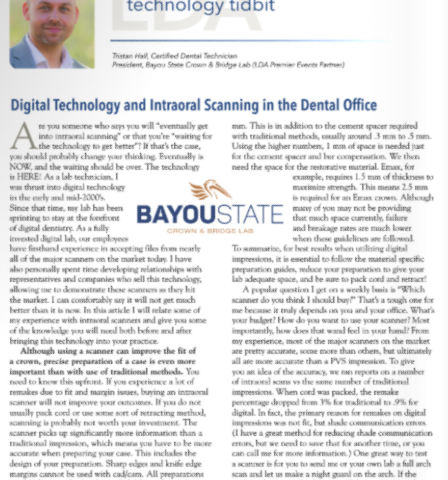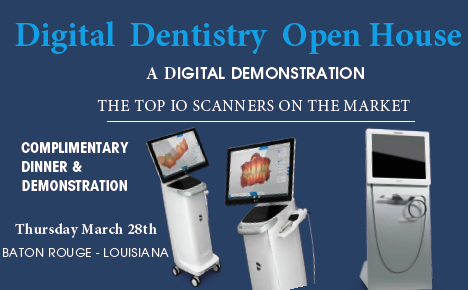- How can we help?
- +1 800-320-0230
- 225-927-8917
- info@bayoustatelab.com
Digital Technology & Intraoral Scanning in the Dental Office
LDA Last Chance Seminar
December 11, 2019
Bayou State Lab Congratulates
February 23, 2021
We are excited that our President Tristan's latest article is now published in the most recent Winter LDA Journal. If you have any questions regarding any thing in the article or any other topic please feel free to give us a call. We hope you enjoy!
Are you someone who says you will “eventually get into intraoral scanning" or that you’re “waiting for the technology to get better"? If that's the case, you should probably change your thinking. Eventually is NOW, and the waiting should be over. The technology is HERE! As a lab technician, I was thrust into digital technology in the early and mid-2000’s. Since that time, my lab has been sprinting to stay at the forefront of digital dentistry. As a fully invested digital lab, our employees have firsthand experience in accepting files from nearly all of the major scanners on the market today. I have also personally spent time developing relationships with representatives and companies who sell this technology, allowing me to demonstrate these scanners as they hit the market. I can comfortably say it will not get much better than it is now. In this article I will relate some of my experience with intraoral scanners and give you some of the knowledge you will need both before and after bringing this technology into your practice.
Although using a scanner can improve the fit of a crown, precise preparation of a case is even more important than with use of traditional methods. You need to know this upfront. If you experience a lot of remakes due to fit and margin issues, buying an intraoral scanner will not improve your outcomes. If you do not usually pack cord or use some sort of retracting method, scanning is probably not worth your investment. The scanner picks up significantly more information than a traditional impression, which means you have to be more accurate when preparing your case. This includes the design of your preparation. Sharp edges and knife edge margins cannot be used with cad/cam. All preparations need to be smoothed and rounded. Material-specific preparation guides must be followed. Finally, your lab needs adequate space to restore. Cad/cam technology requires "bur compensation," ranging from .3 mm to .5 mm. This is in addition to the cement spacer required with traditional methods, usually around .3 mm to .5 mm. Using the higher numbers, 1 mm of space is needed just for the cement spacer and bur compensation. We then need the space for the restorative material. Emax, for example, requires 1.5 mm of thickness to maximize strength. This means 2.5 mm is required for an Emax crown. Although many of you may not be providing that much space currently, failure and breakage rates are much lower when these guidelines are followed. To summarize, for best results when utilizing digital impressions, it is essential to follow the material specific preparation guides, reduce your preparation to give your lab adequate space, and be sure to pack cord and retract!
A popular question I get on a weekly basis is “Which scanner do you think I should buy?" That’s a tough one for me because it truly depends on you and your office. What’s your budget? How do you want to use your scanner? Most importantly, how does that wand feel in your hand? From my experience, most of the major scanners on the market are pretty accurate, some more than others, but ultimately all are more accurate than a PVS impression. To give you an idea of the accuracy, we ran reports on a number of intraoral scans vs the same number of traditional impressions. When cord was packed, the remake percentage dropped from 3% for traditional to .9% for digital. In fact, the primary reason for remakes on digital impressions was not fit, but shade communication errors. (I have a great method for reducing shade communication errors, but we need to save that for another time, or you can call me for more information.) One great way to test a scanner is for you to send me or your own lab a full arch scan and let us make a night guard on the arch. If the scan is taken properly, this test will demonstrate just how accurate the scanner is.
In deciding where to buy a scanner or any other digital equipment, there are several questions I like to ask the seller: 1) How and where do you provide training? For intraoral scanners, the answer should always be in your office by a technical rep. Having you and your staff travel for training is inefficient and costly. Even if the cost of the training is included in the purchase price, you will lose production hours. 2) What kind of support will the company provide after purchase? This is probably the most important question you can ask. Such a highly technical system may glitch or crash. If your office has become reliant on such technology, failures could cost thousands in production. Will the company they have a loaner ready for you while they fix yours? How fast will a representative be out to swap or repair your broken unit? Listen closely to the answers to these questions, and be sure you have the answers written into your agreement. 3) If do not personally know anyone who is using the program you are considering, ask for the names of three other offices where the equipment is in use, and call those dentists for feedback. If it is a good product, the company should have no problem with this request. When you purchase new technology, you are essentially entering into a type of marriage. You need to make certain the company you buy from is the right fit for you and your office.
Finally, I want to give you some thoughts on return on investment when considering digital equipment. Digital equipment is unique in that it usually involves a larger upfront cost with less productive use than traditional equipment. For instance, a $2000 dollar wax pot that lasts 30 years, would make return on investment practically irrelevant since it would easily pay for itself. Digital equipment, on the other hand, can easily be obsolete before it is paid off. At our lab, we usually look at return on investment points for digital equipment at 18 months. If we can get a return in 18 months or less, then we feel it was worth the investment. That being said, having a longer period for return doesn’t mean the equipment is not worth buying. As with any purchase, you should run your numbers, find your savings, and set an appropriate time to get your equipment into the profit zone.
The future of digital dentistry is now. Intraoral scanning technology is great, and it can help your restorative practice become more accurate and add savings to your practice by giving you a competitive edge over others who refuse to change the way they practice. The following quote from Nelson Jackson summarizes the way I feel about technology in our industry: “If we do business today, using yesterday's methods, we won’t be in business tomorrow.” Please feel free to contact me if you have any questions in regards to implementing or exploring intraoral scanning.
Tristan Hall, Certified Dental Technician
President
Bayou State Lab
800-320-0230




